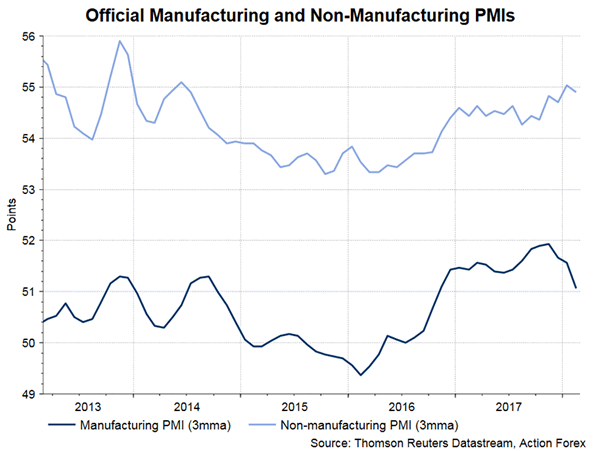China’s official PMIs surprised to the downside in February. Manufacturing PMI dropped -1 point to 50.3 in February, while non-manufacturing PMI slipped -0.9 point to 54.4. The readings came in weaker than expectations of 52.1 and 55 respectively. The Caixin manufacturing index released earlier today, however, increased to 51.6 from January’s 51.5. This beat consensus of 54. Chinese economic data in the first two months of the year are usually volatile due to the week-long Lunar New Year holiday. Yet, the fact that the average of January and February manufacturing PMI (official) remains weaker than that in 4Q17 suggests caution to China’s growth outlook this year.
Consider the official manufacturing PMI, the disappointment was mainly driven by the ‘production’ sub-index which slumped to 50.7 from January’s 53.5, and the ‘new order’ sub-index which fell to 51 in February from 52.6 in January. Concerning other sub-indices, employment dropped -0.2 point to 48.1 in February, while imports and new exports orders sub-indices declined to 49.8 and 49, respectively. Raw materials inventory sub-index added +0.5 point to 49.3 while suppliers’ delivery times dropped -0.8 point to 48.4. On inflation, the input prices sub- index plunged -6.3 point while output prices sub-index lost -2.6 points to 49.2.
The official non-manufacturing PMI covers both the services and construction sectors, roughly in 80%-20% weight. While the February services PMI also came in weaker than the January one, their average was higher than the fourth quarter’s. This suggests that the growth in services activities should help offset the possible moderation in manufacturing activities.
Separately, Caixin manufacturing PMI, which focuses on small and medium firms, climbed +0.1 point to 51.6 in February. Concerning the five major sub-indices, the new orders and raw materials inventory sub-indices rose while production, employment and suppliers’ delivery times eased for the month. For the average of January and February, the headline reading came in at 51.5, compared with 51.1 in 4Q17 with averages of both production and new orders sub-indices higher than those in 4Q17.
More Chinese macroeconomic data would be released later this month. Next week comes the FX reserve and trade balance. The latter would be of focus as the US is about to accelerate restrictions against China to reduce trade deficit. In response, Liu He, Chinese President Xi Jinping’s top economic adviser, has arrived the US in attempt to defuse the trade tensions.















